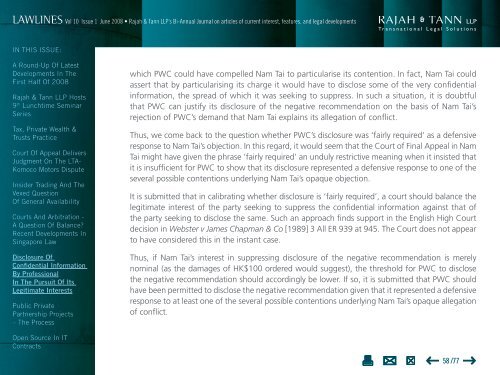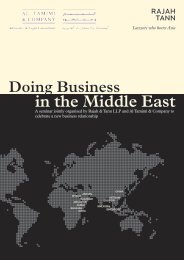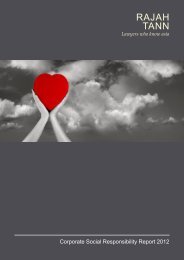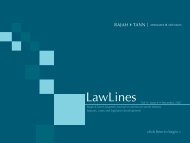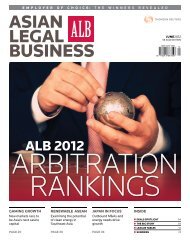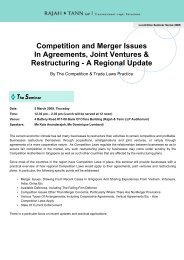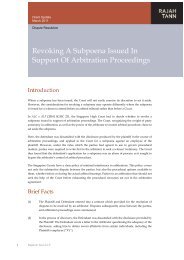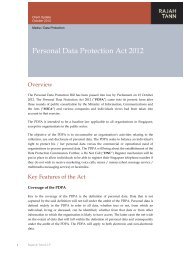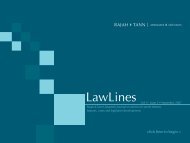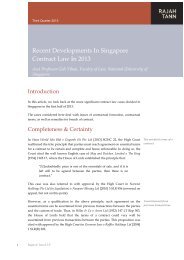Lawlines Vol 10 Issue 1 - eOASIS - Rajah & Tann LLP
Lawlines Vol 10 Issue 1 - eOASIS - Rajah & Tann LLP
Lawlines Vol 10 Issue 1 - eOASIS - Rajah & Tann LLP
Create successful ePaper yourself
Turn your PDF publications into a flip-book with our unique Google optimized e-Paper software.
<strong>Vol</strong> <strong>10</strong> <strong>Issue</strong> 1 June 2008 • <strong>Rajah</strong> & <strong>Tann</strong> <strong>LLP</strong>’s Bi-Annual Journal on articles of current interest, features, and legal developmentsIN THIS ISSUE:A Round-Up Of LatestDevelopments In TheFirst Half Of 2008<strong>Rajah</strong> & <strong>Tann</strong> <strong>LLP</strong> Hosts9 th Lunchtime SeminarSeriesTax, Private Wealth &Trusts PracticeCourt Of Appeal DeliversJudgment On The LTA-Komoco Motors DisputeInsider Trading And TheVexed QuestionOf General AvailabilityCourts And Arbitration -A Question Of Balance?Recent Developments InSingapore LawDisclosure OfConfidential InformationBy ProfessionalIn The Pursuit Of ItsLegitimate InterestsPublic PrivatePartnership Projects– The Processwhich PWC could have compelled Nam Tai to particularise its contention. In fact, Nam Tai couldassert that by particularising its charge it would have to disclose some of the very confidentialinformation, the spread of which it was seeking to suppress. In such a situation, it is doubtfulthat PWC can justify its disclosure of the negative recommendation on the basis of Nam Tai’srejection of PWC’s demand that Nam Tai explains its allegation of conflict.Thus, we come back to the question whether PWC’s disclosure was ‘fairly required’ as a defensiveresponse to Nam Tai’s objection. In this regard, it would seem that the Court of Final Appeal in NamTai might have given the phrase ‘fairly required’ an unduly restrictive meaning when it insisted thatit is insufficient for PWC to show that its disclosure represented a defensive response to one of theseveral possible contentions underlying Nam Tai’s opaque objection.It is submitted that in calibrating whether disclosure is ‘fairly required’, a court should balance thelegitimate interest of the party seeking to suppress the confidential information against that ofthe party seeking to disclose the same. Such an approach finds support in the English High Courtdecision in Webster v James Chapman & Co [1989] 3 All ER 939 at 945. The Court does not appearto have considered this in the instant case.Thus, if Nam Tai’s interest in suppressing disclosure of the negative recommendation is merelynominal (as the damages of HK$<strong>10</strong>0 ordered would suggest), the threshold for PWC to disclosethe negative recommendation should accordingly be lower. If so, it is submitted that PWC shouldhave been permitted to disclose the negative recommendation given that it represented a defensiveresponse to at least one of the several possible contentions underlying Nam Tai’s opaque allegationof conflict.Open Source In ITContracts58 /77


